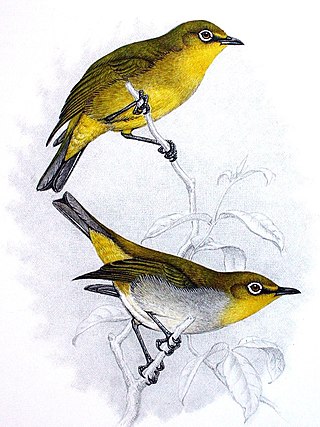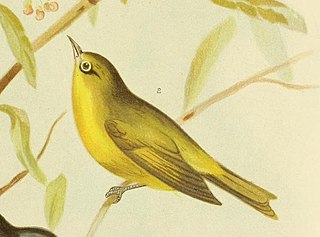
Zosterops is a genus of passerine birds containing the typical white-eyes in the white-eye family Zosteropidae. The genus has the largest number of species in the white-eye family. They occur in the Afrotropical, Indomalayan, and Australasian realms. Typical white-eyes have a length of between 8 and 15 cm. Their most characteristic feature is a conspicuous white feather ring around the eye, though some species lack it. The species in this group vary in the structural adaptations of the tongue. The Zosterops [griseotinctus] group is an example of a "great speciator" inhabiting a vast area and showing a remarkable morphological differentiation on islands, some of which maybe as close as 2 km (1.2 mi) apart.

The Sri Lanka white-eye is a small passerine bird in the white-eye family, which is endemic to Sri Lanka. It is a resident breeder in forests, gardens and plantations, mainly in the highlands.

The warbling white-eye, also known as the Japanese white-eye and mountain white-eye, is a small passerine bird in the white-eye family. The specific epithet is occasionally written japonica, but this is incorrect due to the gender of the genus. Its native range includes much of East Asia, including the Russian Far East, Japan, Indonesia, Korea, and the Philippines. It has been intentionally introduced to other parts of the world as a pet and as pest control, with mixed results. As one of the native species of the Japanese islands, it has been depicted in Japanese art on numerous occasions, and historically was kept as a cage bird.

The Cape white-eye is a small passerine bird in the white-eye family. It is native to southern Africa. It is commonly found in suburbia, parks and gardens, besides a variety of mesic to well-watered habitats.

The bridled white-eye is a species of white-eye native to the Mariana Islands and formerly Guam. The species' natural habitat is tropical forests, shrublands and urban areas.

The Fiji white-eye is a species of passerine bird in the white-eye family Zosteropidae. The species is also known as Layard's white-eye.

The Javan white-eye is a bird species in the family Zosteropidae that occurs in Java and Borneo. It is threatened by trapping for wildlife trade and has been assessed as Endangered on the IUCN Red List in 2019, as the wild population declined significantly.

The capped white-eye is a species of bird in the family Zosteropidae. It is found in New Guinea. Its natural habitat is in subtropical or tropical moist montane forests. It has a white eye ring, round wings, and strong legs. The capped white-eyes are sociable and live in large flocks. The Oya Tabu white-eye of the D'Entrecasteaux Islands was formerly considered a subspecies, but is now thought to be a distinct species.

The canary white-eye or yellow white-eye is a species of white-eye endemic to northern Australia in subtropical or tropical mangrove forests. Its common name reflects the circle of white feathers around its eye.

The Sangihe white-eye is a species of bird in the white-eye family. It is endemic to Sangihe, Indonesia.

The yellowish white-eye or golden-yellow white-eye, is a species of bird in the family Zosteropidae. It is endemic to the Philippines.

The olive-colored white-eye, also known as the olive white-eye, Yap olive white-eye or great Yap white-eye, is a species of bird in the family Zosteropidae.

Heuglin's white-eye, also known as the Ethiopian white-eye, is a species of bird in the family Zosteropidae. It is found in north-eastern and eastern Africa, primarily in Ethiopia and Kenya. Its natural habitats range from subtropical or tropical moist montane forests, to subtropical or tropical high-altitude shrubland, plantations, and rural gardens.

The citrine white-eye, or Caroline Islands white-eye, is a species of bird in the family Zosteropidae. It is found in Palau and the Federated States of Micronesia.

The northern yellow white-eye, formerly the African yellow white-eye, is a species of bird in the family Zosteropidae. It is found across sub-Saharan Africa, from Senegal in the west across to southern Sudan in the east and south to northern Angola.

The green-backed white-eye is a species of bird in the family Zosteropidae. It is also known as the New Caledonian white-eye. It is endemic to New Caledonia.

The Togian white-eye is a species of bird in the family Zosteropidae.
Taita white-eye is a species of bird in the family Zosteropidae. It includes numerous subspecies, sometimes considered a subspecies to montane white-eye. It is only found in Taita Hills in southeastern Kenya. IUCN categorizes it as vulnerable. It is threatened by severe habitat loss and fragmentation, mainly as a result of the deforestation of the Taita Hills.

The sangkar white-eye is a bird species in the family Zosteropidae. It is also known as the Sunda white-eye. It is found in forested habitats on the Indonesian islands of Java and Bali. In Java it is typically found at elevations between 200–1,600 m (660–5,250 ft), but it sometimes occurs at lower elevations as well.

The Meratus white-eye is a species of bird in the white-eye family, Zosteropidae. The species was described in 2021 by the Indonesian ornithologist Mohammed Irham and his colleagues based on genetic, morphological, and vocal differences from other Zosterops white-eyes. It is endemic to the Meratus Mountains of Indonesian Borneo, where it has been recorded from Mount Besar and Mount Karokangen. It inhabits the mid and lower storeys of closed-canopy montane forests at elevations between 1,300 and 1,650 m. It is a typical Zosterops white-eye, with deep olive-green upperparts, yellower underparts, a yellow stripe across the lores, and a distinctive bicoloured bill. Adults have a length of around 11–12 cm (4.3–4.7 in) and a mass of 8.5–9.5 g (0.30–0.34 oz). Both sexes look alike.




















